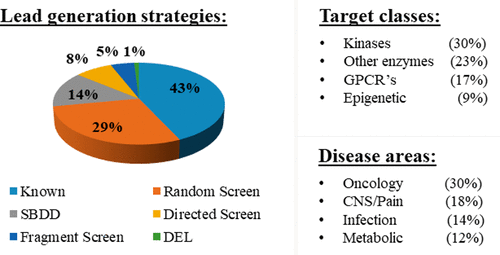当前位置:
X-MOL 学术
›
J. Med. Chem.
›
论文详情
Our official English website, www.x-mol.net, welcomes your
feedback! (Note: you will need to create a separate account there.)
Where Do Recent Small Molecule Clinical Development Candidates Come From?
Journal of Medicinal Chemistry ( IF 6.8 ) Pub Date : 2018-06-19 00:00:00 , DOI: 10.1021/acs.jmedchem.8b00675 Dean G. Brown 1 , Jonas Boström 2
Journal of Medicinal Chemistry ( IF 6.8 ) Pub Date : 2018-06-19 00:00:00 , DOI: 10.1021/acs.jmedchem.8b00675 Dean G. Brown 1 , Jonas Boström 2
Affiliation

|
An analysis of 66 published clinical candidates from Journal of Medicinal Chemistry has been conducted to shed light on which lead generation strategies are most frequently employed in identifying drug candidates. The most frequent lead generation strategy (producing a drug candidate) was based on starting points derived from previously known compounds (43%) followed by random high throughput screening (29%). The remainder of approaches included focused screening, structure-based drug design (SBDD), fragment-based lead generation (FBLG), and DNA-encoded library screening (DEL). An analysis of physicochemical properties on the hit-to-clinical pairs shows an average increase in molecular weight (ΔMW = +85) but no change in lipophilicity (ΔclogP = −0.2), although exceptions are noted. The majority (>50%) of clinical candidates were found to be structurally very different from their starting point and were more complex. Finally, several reports of noncovalent scaffolds modified by a covalent warhead using SBDD approaches are discussed.
中文翻译:

最近的小分子临床开发候选人来自何处?
对《药物化学杂志》上66位已发表临床候选药物的分析已经进行了研究以阐明在识别候选药物时最常采用的潜在顾客生成策略。最频繁的潜在顾客生成策略(产生候选药物)是基于先前已知化合物的起始点(43%),然后是随机高通量筛选(29%)。其余方法包括集中筛选,基于结构的药物设计(SBDD),基于片段的线索生成(FBLG)和DNA编码的文库筛选(DEL)。对命中至临床对的理化性质的分析显示,平均分子量增加(ΔMW= +85),但亲脂性没有变化(ΔclogP= -0.2),尽管有例外。发现大多数(> 50%)临床候选者与他们的起点在结构上有很大不同,并且更为复杂。最后,
更新日期:2018-06-19
中文翻译:

最近的小分子临床开发候选人来自何处?
对《药物化学杂志》上66位已发表临床候选药物的分析已经进行了研究以阐明在识别候选药物时最常采用的潜在顾客生成策略。最频繁的潜在顾客生成策略(产生候选药物)是基于先前已知化合物的起始点(43%),然后是随机高通量筛选(29%)。其余方法包括集中筛选,基于结构的药物设计(SBDD),基于片段的线索生成(FBLG)和DNA编码的文库筛选(DEL)。对命中至临床对的理化性质的分析显示,平均分子量增加(ΔMW= +85),但亲脂性没有变化(ΔclogP= -0.2),尽管有例外。发现大多数(> 50%)临床候选者与他们的起点在结构上有很大不同,并且更为复杂。最后,











































 京公网安备 11010802027423号
京公网安备 11010802027423号